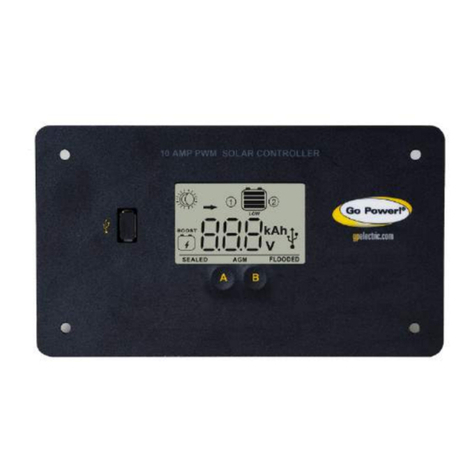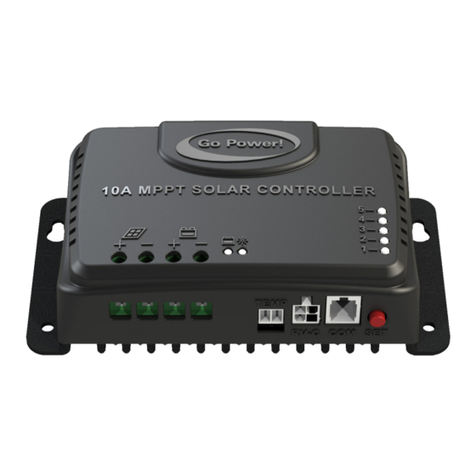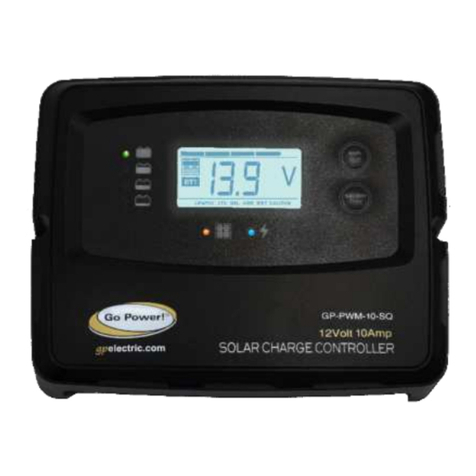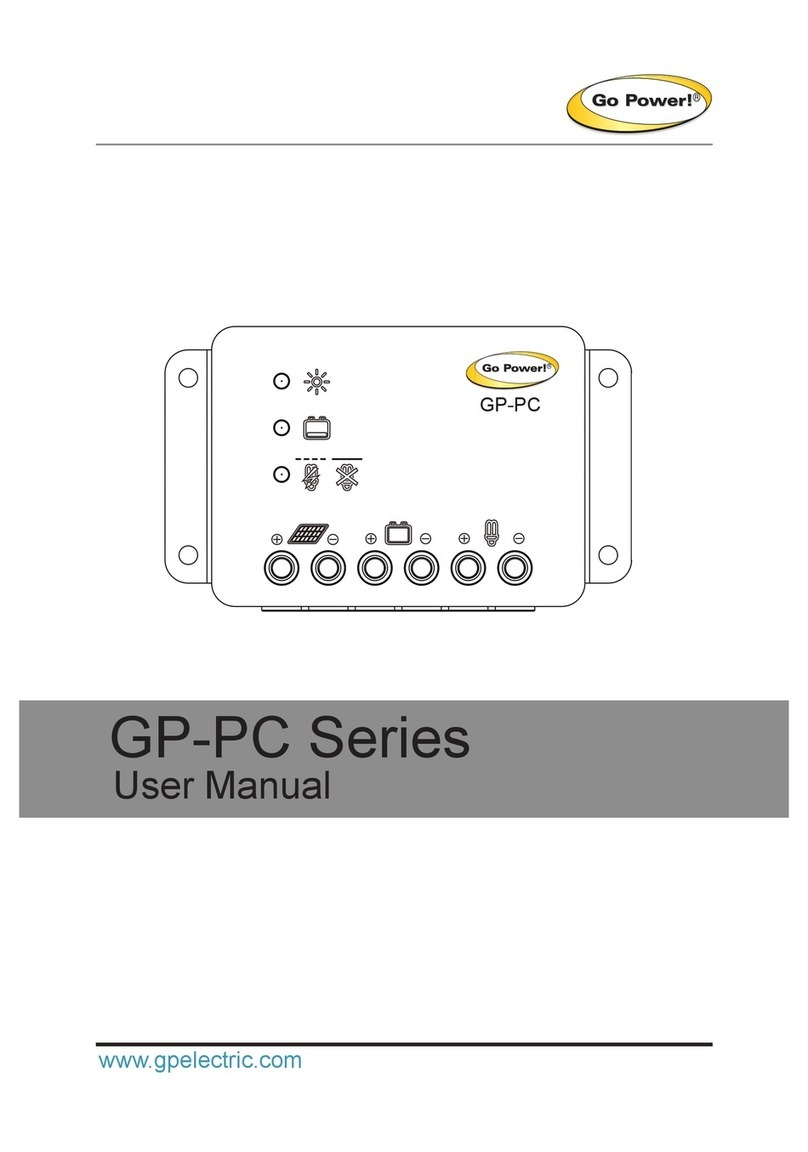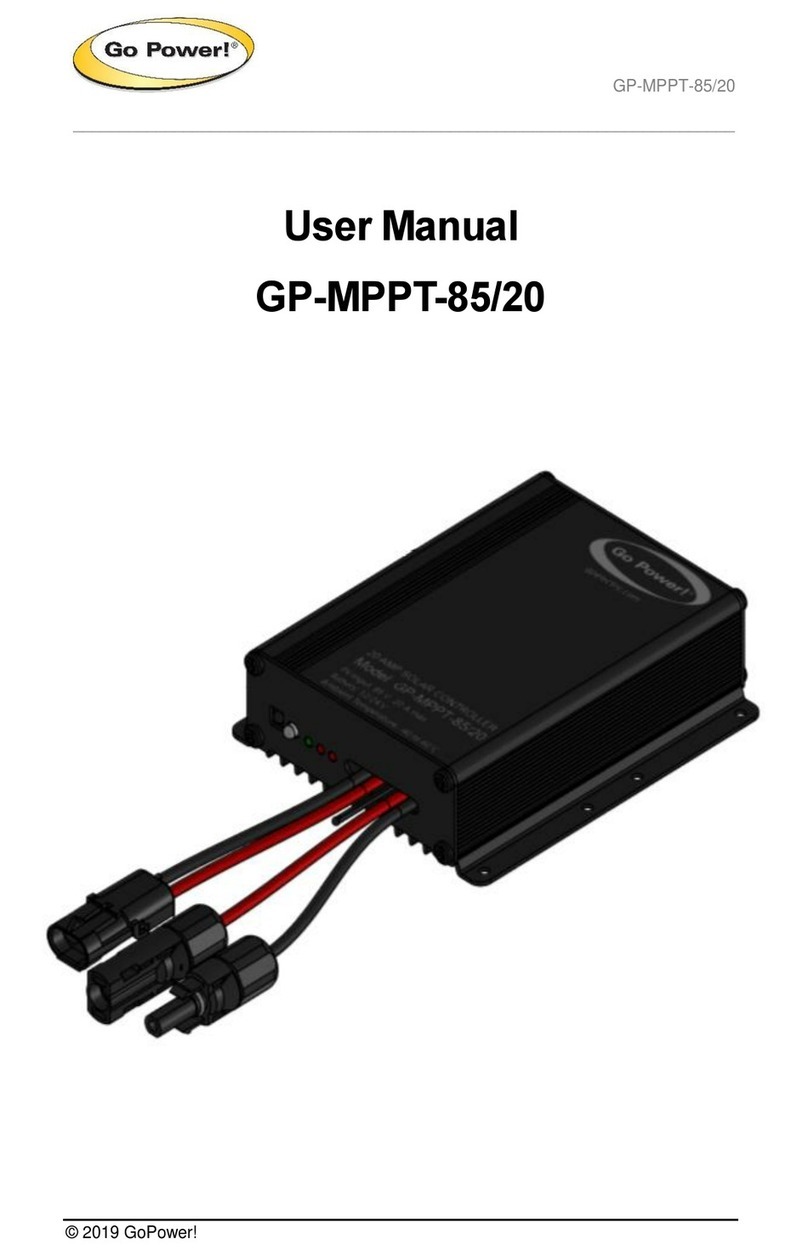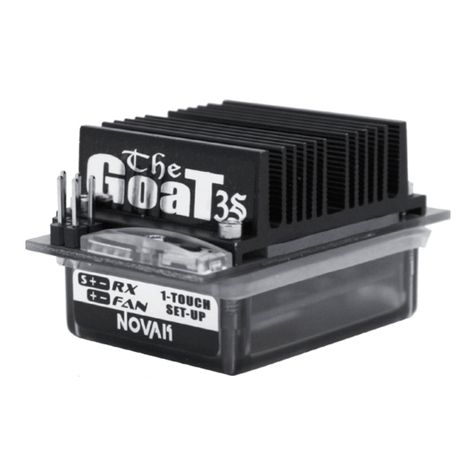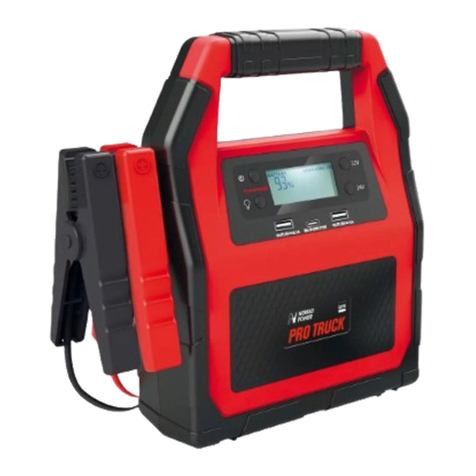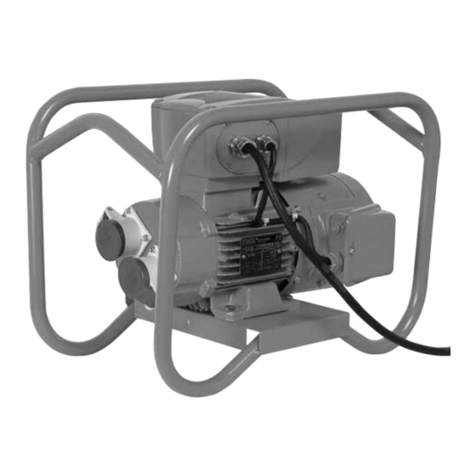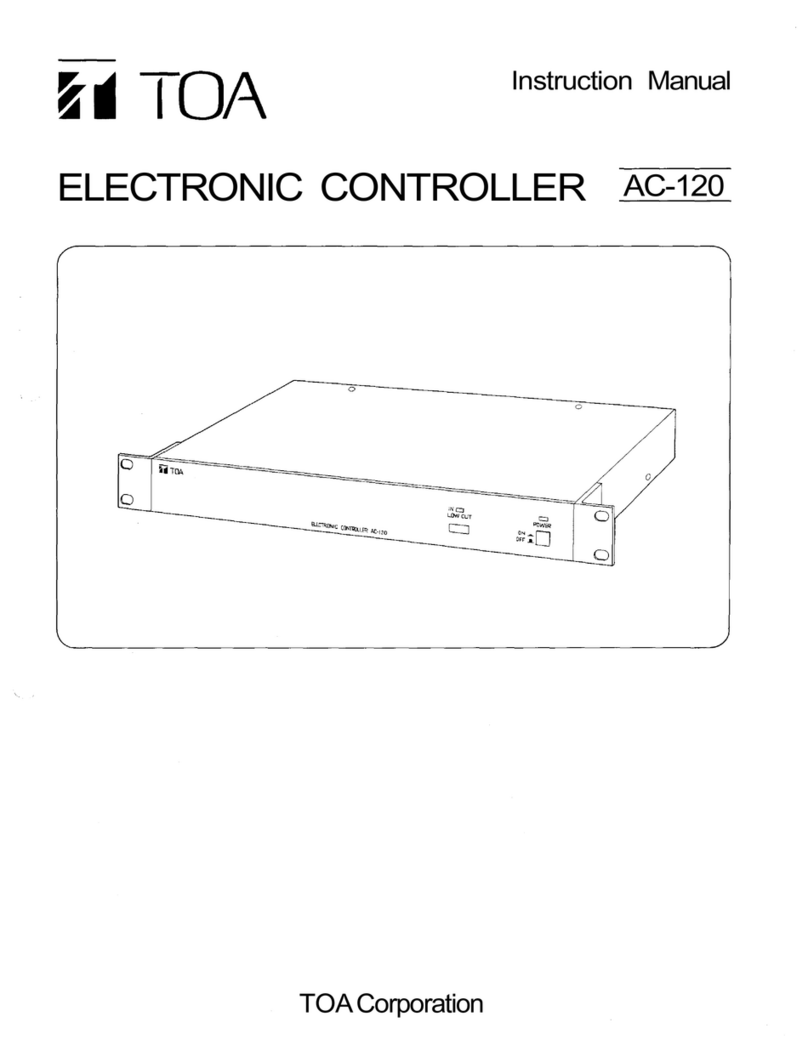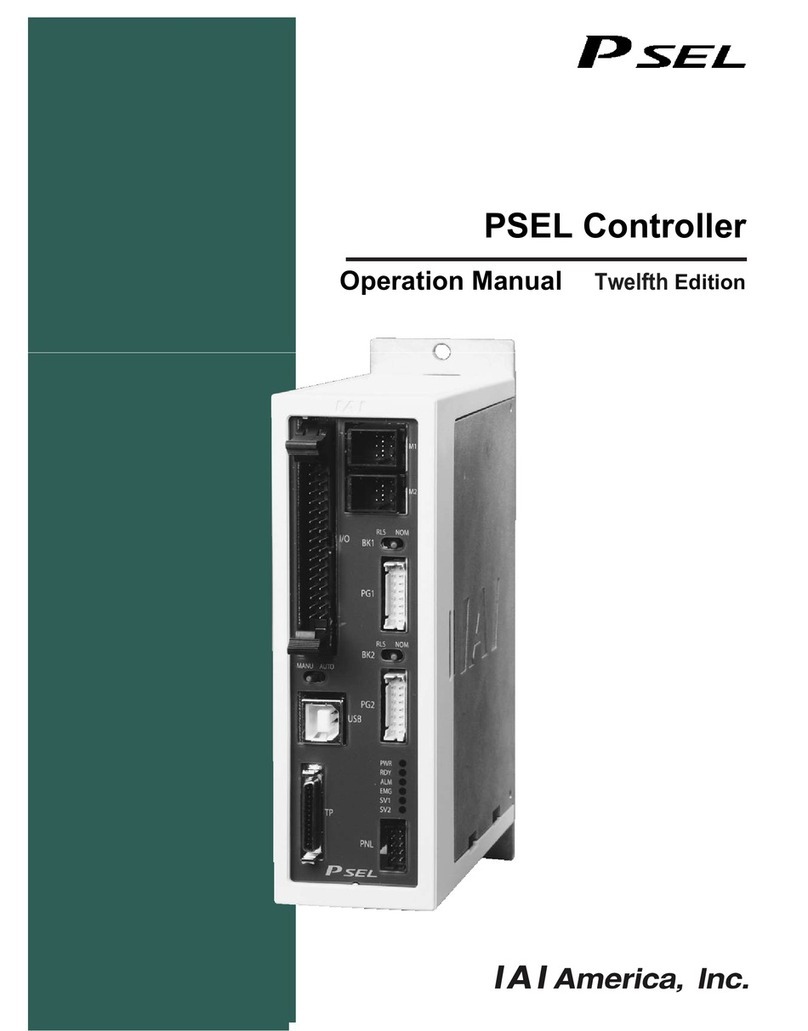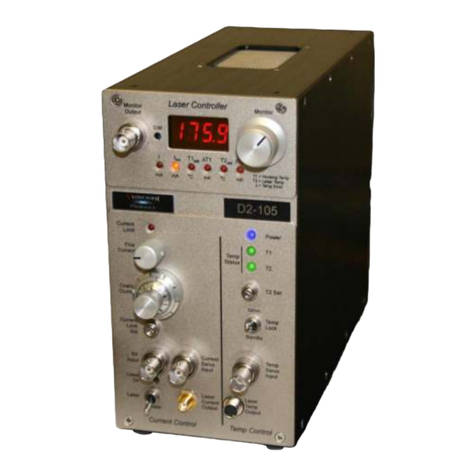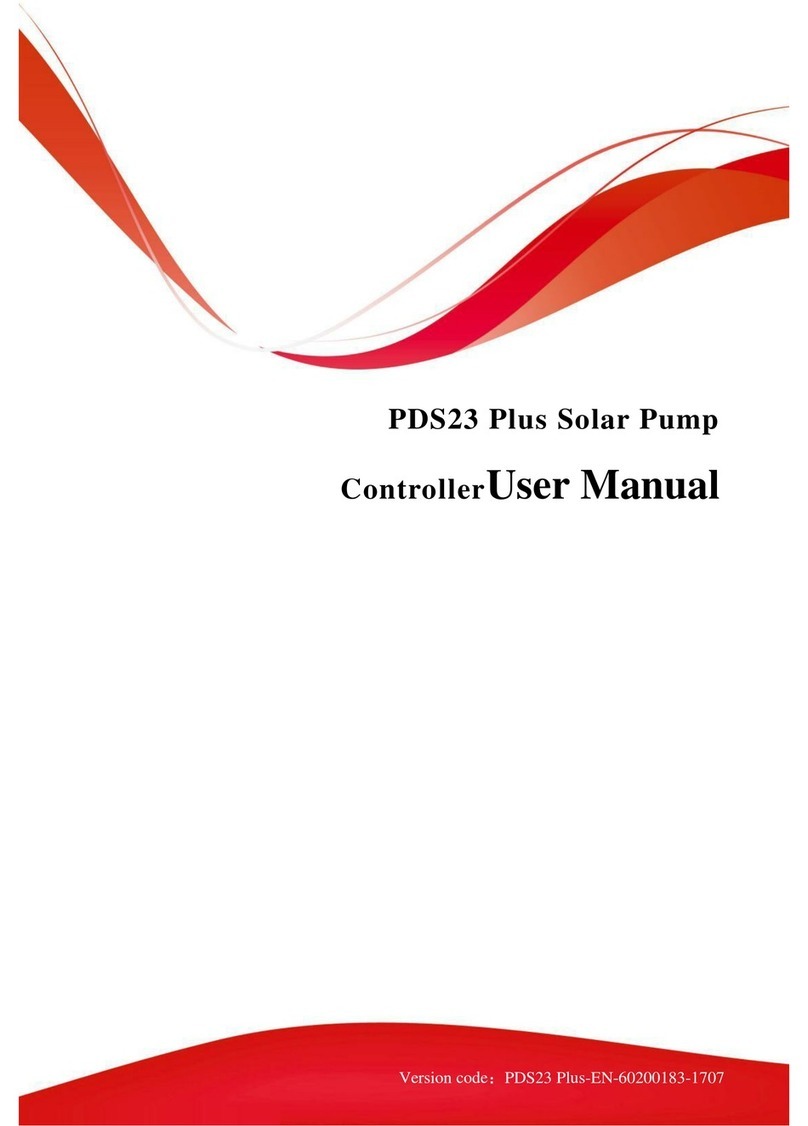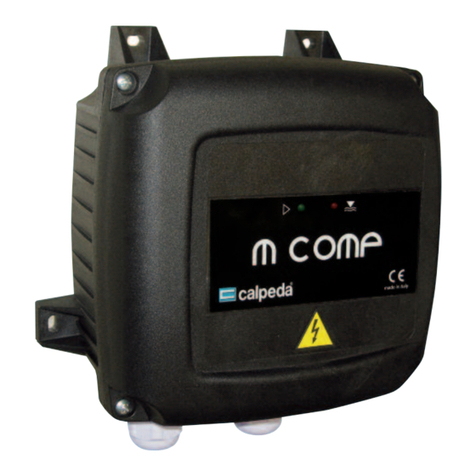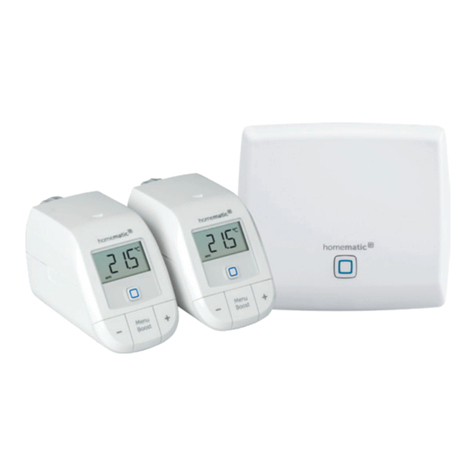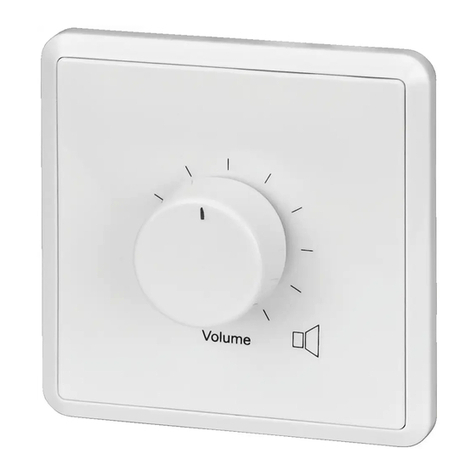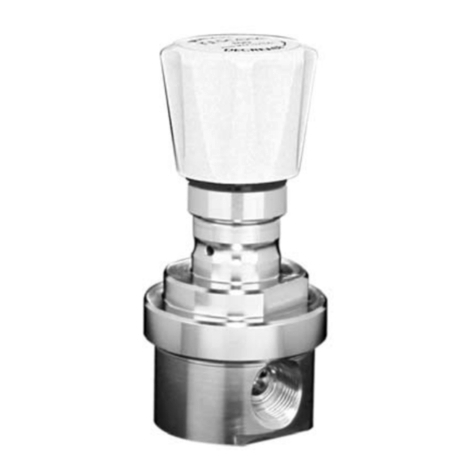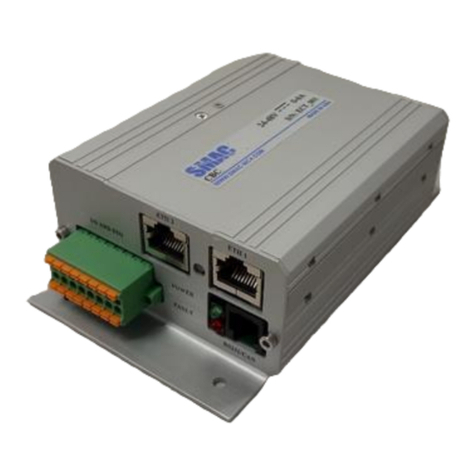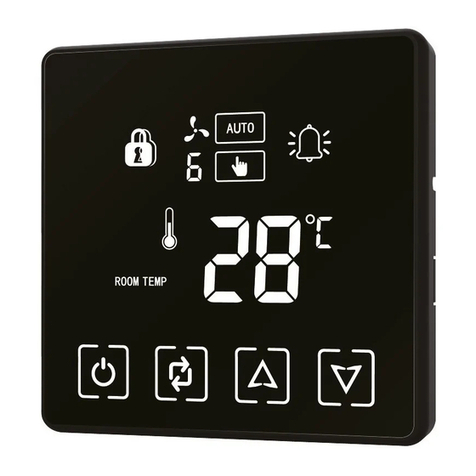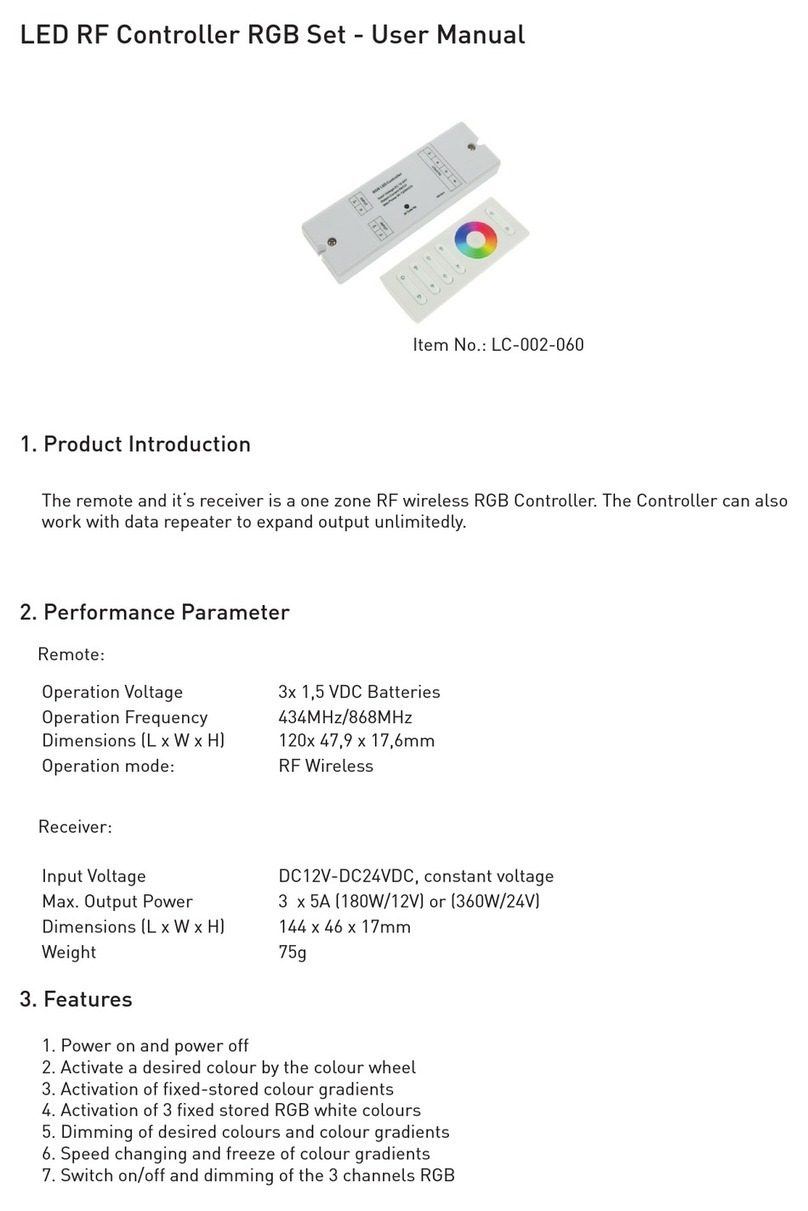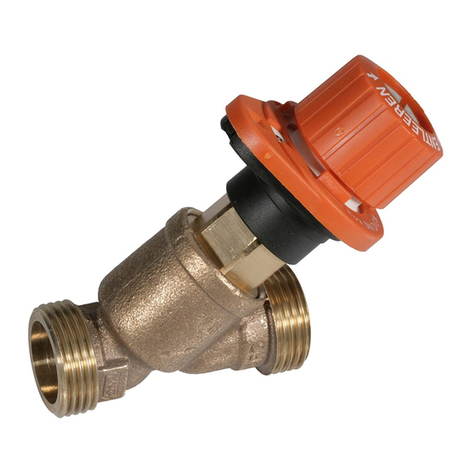Go Power MPPT-PRO Series User manual

MPPT-PRO
Solar Controller
User Manual
GP-MPPT-PRO-60
© 2020 Go Power!
Worldwide Technical Support and Product Information gpelectric.com
Go Power!
201-710 Redbrick Street Victoria, BC, V8T 5J3
Tel: 1.866.247.6527
82804_MAN_GP-MPPT-PRO-60_RevA

Congratulations on purchasing your Go Power! MPPT Solar Controller!
Record the unit’s model and serial number below. It is much easier and quicker to record this information now at the pre-installation
stage.
Model Number:
Serial Number:
Date of Install:
Battery Bank Information: (size, install date, battery type)
Product Packaging
Please safely store the packing the product was delivered in or recycle the packaging components as outlined below:
LDPE
Low Density
Polyetheylene
CFB
3
4
7
CFB
3
4
7
CFB
3
4
7
CFB
3
4
7
CFB
3
4
7
Corrugated berboard
main box
Plastic
foam protection
Plastic
accessories bag
www.earth911.com/recycling-center-search-guides
Local recycling centers can be found here:
Corrugated
Recycles
www.corrugated.org

gpelectric.com | [page 3]
CONTENTS
1. INTRODUCTION .................................................................................................................................5
1.1 SAFETY PRECAUTIONS ........................................................................................................................... 5
1.2 OVERVIEW.................................................................................................................................................. 6
1.3 FEATURES .................................................................................................................................................. 6
1.4 APPEARANCE ............................................................................................................................................ 7
1.5 MPPT TECHNOLOGY ................................................................................................................................ 8
1.6 CHARGING STAGES................................................................................................................................ 10
2. TECHNICAL PARAMETERS....................................................................................................... 11
2.1 ELECTRICAL PARAMETERS..................................................................................................................... 11
2.2 BATTERY TYPE DEFAULT PARAMETERS ............................................................................................... 12
3. CONVERSION EFFICIENCY CURVE....................................................................................13
3.1 12V SYSTEMS............................................................................................................................................... 13
3.2 24V SYSTEMS............................................................................................................................................... 13
4. PRODUCT DIMENSIONS.............................................................................................................14
5. STATUS DISPLAY.............................................................................................................................14
5.1 LED INDICATION........................................................................................................................................ 14
5.1.1 PV INDICATOR .............................................................................................................................. 14
5.1.2 BATTERY INDICATOR .................................................................................................................. 15
5.1.3 LOAD INDICATOR ......................................................................................................................... 15
5.1.4 ERROR INDICATOR...................................................................................................................... 15
6. OPERATION AND DISPLAY........................................................................................................16
6.1 LCD MAIN INTERFACE ................................................................................................................................. 16
6.1.2 NAVIGATION BUTTONS ............................................................................................................... 16
6.1.3 ICON DESCRIPTION..................................................................................................................... 17
6.1.4 MENU BLOCK DIAGRAM ............................................................................................................. 17
6.1.5 REAL-TIME MONITORING ........................................................................................................... 18
6.1.6 SYSTEM PARAMETER SETTINGS ................................................................................................ 19
6.1.7 CONTROLLER CHARGING AND DISCHARGING RELATED PARAMETER SETTINGS.............. 21
6.1.8 LCD SCREEN BACKLIGHT TIME SETTING .................................................................................. 21
6.1.9 CONTROLLER ABNORMALITY VOICE ALARM - ON/OFF SETTING ........................................... 21
6.1.10 CLEAR HISTORICAL DATA AND RESET TO FACTORY SETTINGS........................................... 22
6.1.11 LOAD MODES ............................................................................................................................... 22
6.1.12 STATISTIC DATA ........................................................................................................................... 23
6.1.13 HISTORICAL DATA OF THE CURRENT DAY ............................................................................... 23
6.1.14 DEVICE INFORMATION................................................................................................................ 24
7. INSTALLATION................................................................................................................................25
7.1 TOOLS AND MATERIALS NEEDED.............................................................................................................. 25
7.2 INSTALLATION AND WIRING ..................................................................................................................... 25
7.3 WIRING FOR PARALLEL OPERATIONS................................................................................................... 28
7.3.1 WIRING DIAGRAM ........................................................................................................................ 28
7.3.2 ORDER OF CONNECTION........................................................................................................... 29
7.3.3 INTERFACE DEFINITION ............................................................................................................. 29
7.3.4 PARAMETER SETTING ................................................................................................................ 29
www.earth911.com/recycling-center-search-guides

[page 4] | gpelectric.com
CONTENTS
8. BLUETOOTH®DONGLE..................................................................................................... 31
8.1 BLUETOOTH®ADAPTER PRODUCT INTRODUCTION........................................................................31
8.2 MAIN FEATURES ..................................................................................................................................31
8.3 LED STATUS..........................................................................................................................................31
8.4 APPLICABLE TYPE...............................................................................................................................31
8.5 PRODUCT FEATURES .........................................................................................................................32
8.6 PRODUCT DIMENSIONS.....................................................................................................................32
8.7 SYSTEM WIRING DIAGRAM ...............................................................................................................33
8.8 SPECIFICATIONS .................................................................................................................................33
9. REMOTE ..................................................................................................................................... 34
9.1 PRODUCT FEATURES ...........................................................................................................................34
9.2 APPEARANCE.......................................................................................................................................34
9.3 INSTALLATION DIMENSIONS.............................................................................................................35
9.4 COMMON PROBLEMS AND SOLUTIONS.............................................................................................35
9.5 FAULT INDICATION AND COMMUNICATION INDICATION .............................................................36
10. SYSTEM MAINTENANCE.................................................................................................. 37
10.1 ERROR AND WARNINGS ..................................................................................................................37
11. WARRANTY............................................................................................................................... 38
11.1 REPAIR AND RETURN INFORMATION ............................................................................................38

gpelectric.com | [page 5]
1.1 SAFETY PRECAUTIONS
Important safety information is contained throughout this manual that should be carefully observed and followed. This
information is presented using the following format.
The information is categorized in two ways:
Warning: Bodily harm could occur if instructions are not explicitly followed. If there are any doubts about the procedure or
conditions, please call GoPower! technical support before doing anything.
Caution: Damage to property could occur if instructions are not followed properly.
The following symbols are used to indicate the type of hazard.
GENERAL SAFETY
• Read entire manual before installation
•
Any voltage above 30 VDC should be considered dangerous. Make sure power is disconnected before touching
terminals that exceed this voltage.
•
There are no parts inside the controller that need to be maintained or repaired. The controller shall never be disassembled
• Unless otherwise specied, all terminal blocks should be re-tightened at least every 6 months to prevent possible re
caused by connections that have vibrated loose.
•
Ensure all connections are tight and secure. Loose connections may generate sparks and heat. Be sure to check
connections one week after installation to ensure they are still tight.
SOLAR CONTROLLER SAFETY
•
Always connect the battery BEFORE connecting the solar array to prevent damage to the controller. If the battery
wires need to be disconnected, the solar array wires should rst be disconnected.
•
To prevent damage to the controller, ensure the solar array voltage does not exceed the maximum voltage of the solar
controller. See specications table below to determine the limit for your controller.
BATTERY SAFETY
• Ensure the battery type is set correctly in the controller settings to avoid possible explosion or re
• Read manual for battery and observe safety precautions before connecting the battery to the controller
• Only use deep cycle batteries that are intended for energy storage applications
Warning / Caution: Result
Description of condition leading to result
1. INTRODUCTION
SYMBOL MEANING SYMBOL MEANING
General Warning Hot Surface
Risk of Shock Risk of Fire
Risk of Electrocution Risk of Chemicals
Risk of Explosion Risk of Eye Injury
SYMBOL

[page 6] | gpelectric.com
INTRODUCTION
1.2 OVERVIEW
Solar controllers, or solar charge controllers, continuously monitors the solar panel’s generating power and tracks the
highest voltage and current values (VI) in real time, enabling the system to charge the battery to maximum power. It’s
designed to be used in o-grid solar photovoltaic systems to coordinate operation of the solar panel, battery, and load,
functioning as the core control unit in o-grid photovoltaic systems.
This product features an LCD screen which displays the operating status, operating parameters, controller logs, and
control system parameters. Users can conveniently check parameters using the buttons and modify control parameters to
cater to dierent system requirements.
The controller utilizes standard Modbus communication protocol, making it easy for users to check and modify system
parameters on their own. An optional Bluetooth®adapter gives users access to remote monitoring.
With comprehensive electronic fault self-detecting functions and powerful electronic protection functions built inside the
controller, component damage caused by installation errors or system failures can be avoided.
1.3 FEATURES
• Advanced multi-peak tracking technology. When the solar panel is shadowed or part of the panel fails resulting in
multiple peaks on the I-V curve, the controller is still able to accurately track the maximum power point.
• Built-in maximum power point tracking (MPPT) algorithm signicantly increases energy utilization eciency of the
photovoltaic system, (about 15% to 20% higher than traditional PWM charging.)
• Provides an active charging voltage regulation feature. At battery open circuit or lithium battery BMS overcharge
protection, the controller battery terminal will output the rated charging voltage value.
• MPPT tracking allows up to 99.9% eciency.
• Uses advanced digital power technology to increase the circuit energy conversion eciency to as high as 98%.
• Supports multple battery chemistries, including lithium, sealed, vented, AGM, and ooded Lead Acid.
• Current-limited charging mode. When the power of solar panel is too large and the charging current is higher than the
rated value, the controller automatically reduces the charging power so that the solar panel can operate at the rated
charging current.
• Supports automatic identication of lead-acid battery voltage.
• Features LED fault indicators and an LCD screen, which can display abnormal information, helps users to quickly
identify system faults.
• Historical data storage function is available, and data can be stored for up to a year
• The controller is equipped with an LCD screen allowing users to easily check device operation and statuses and
modify controller parameters
• Supports standard Modbus protocol to meet dierent options.
• Built-in over-temperature protection ensures that when temperature exceeds the set value of the device, the charging
current decreases linearly with the temperature, which reduces an increase in the controller’s temperature, avoiding
damage.
• Temperature compensation and automatic adjustment of charge and discharge parameters help to improve battery
life.
• Solar panel short circuit protection, battery open circuit protection and TVS transient protection.

gpelectric.com | [page 7]
1.4 APPEARANCE
NO. NAME NO. NAME
1 Charging indicator 9 Communication
port
2 Battery indicator 10 Battery voltage
compensation interface
3 Load indicator 11 Solar Panel “+”
4 Error indicator 12 Solar Panel “-”
5 LCD screen 13 Battery “-”
6 Operating buttons 14 Load “-”
7External temperature
sampling interface 15 Battery “+”
8RS485 communication
interface 16 Load “+”
INTRODUCTION

[page 8] | gpelectric.com
INTRODUCTION
1.5 MPPT TECHNOLOGY
Maximum Power Point Tracking (MPPT) is an advanced charging technology that more eciently harvests power from
solar panels in all conditions. It does this by continuously tracking the I-V curve of the solar array and modifying operating
conditions to maximize output power. Figure 1-2 shows the MPPT point compared to a traditional PWM charger, which
always runs the solar array at the same operating conditions.
Due to dierences in ambient temperature and light conditions, the maximum power point often changes. The MPPT
controller can adjust parameters according to quickly changing conditions to keep the system near to its maximum
working point. The whole process is fully automatic and does not require any adjustments by users.
FIGURE 1-2 Solar panel output characteristics curve
FIGURE 1-3 Relationship between solar panel output characteristics and light

gpelectric.com | [page 9]
INTRODUCTION
In partially shaded conditions there can also be multiple peaks in the P-V curve that can confuse an MPPT algorithm.
Shown in Figure 1-5 is a series string of solar panels and a corresponding graph that shows lower maximum power points
(LMPP) and the greater maxim power point (GMPP) that will result in maximum energy transfer. The GP-MPPT-PRO
series has a smart algorithm that will always choose the right peak.
FIGURE 1-4 Relationship between solar panel output characteristics and temperature
(A)

[page 10] | gpelectric.com
INTRODUCTION
1.6 CHARGING STAGES
Maximum power point tracking is used to charge the batteries with the highest current possible, but this is only part of the
equation. A battery cannot be charged at maximum power all the time for safety reasons, so multiple stages are used.
These stages include bulk, boost, oat and, for some types of batteries, equalization as shown in Figure 1-6.
FIGURE 1-5 Multiple peaks resulting from partial shading
(B)
FIGURE 1-6 Battery charging stages curve graph

gpelectric.com | [page 11]
2. TECHNICAL PARAMETERS
2.1 ELECTRICAL PARAMETERS
ITEMS PARAMETERS
MODEL GP-MPPT-PRO-60
SYSTEM VOLTAGE 12V/24V
ZERO LOAD LOSS <10mA
BATTERY VOLTAGE 9V~32V
MAXIMUM PV OPEN
CIRCUIT VOLTAGE 92V(25˚C); 100V(Lowest Ambient Temperature)
MAXIMUM POWER
POINT VOLTAGE
RANGE
(Battery voltage +2V) ~ 72V
RATED CHARGING
CURRENT 60A
MAXIMUM PV INPUT
POWER 1040W/12V; 2080W/24V; 3120W/36V; 4160W/48V
CHARGING
CONVERSION
EFFICIENCY
≤98%
MPPT TRACKING
EFFICIENCY >99%
TEMPERATURE
COMPENSATION
COEFFICIENT
-3mv/˚C/2V (default); Lithium battery features no temperature compensation
OPERATING
TEMPERATURE -35˚C ~ +45˚C
IP RATING IP32
WEIGHT 3.6kg/7.9lbs
COMMUNICATION
MODE TTL Serial communication
ALTITUDE ≤ 3000 meters
DIMENSIONS (mm) 238 x 205 x 93

[page 12] | gpelectric.com
TECHNICAL PARAMETERS
STAGE 1: BULK
In quick charge stage, the battery voltage has not yet reached the set value of full charge voltage (i.e. equalizing/boost
charge voltage) and the controller will perform MPPT charging, which will provide maximum solar energy to charge the
battery. When the battery voltage reaches the pre-set value, Stage 2 charge will start.
STAGE 2: BOOST
When the battery voltage reaches the boost voltage, the controller will perform constant voltage charging. This is no
longer MPPT charging, and the charging current will gradually decrease with time.
STAGE 3: FLOAT
Float charge is conducted following the boost charge stage. The controller will reduce the charge current to a small
amount in order to prevent self-discharge of the battery and keep it fully charged. If the load exceeds this small current
the battery voltage will start to decrease until it reaches the recharge voltage. When the battery voltage falls below the
recharge voltage, the controller will switch back to bulk charging.
STAGE 4: EQUALIZE
Warning: Risk of explosion!
Equalizing vented lead-acid battery may generate explosive gases. So, the battery
compartment must be well ventilated.
Caution: Damage of device!
Equalization can increase the battery voltage to levels that may damage sensitive DC loads.
It is necessary to verify that the allowable input voltage of all system loads is greater than the
equalizing charge set value.
Caution: Damage of device!
Over charge and excessive gas evolution may damage the battery plates and cause active
substances on the battery plate to come o. Equalizing charge may cause damage if voltage
is too high or time is too long. Please carefully check the specic requirements of battery
used in the system.
Certain types of battery benet from regular equalizing charge, which can stir electrolyte, balance battery voltage, and
complete chemical reaction. The equalize charge increases the battery voltage above a standard voltage, causing
vaporization of battery electrolyte. By default, this happens every 28 days.
When the controller is not able to stabilize battery voltage due to the inuence of installation
environment or load, the controller will wait for 3 hours (or custom value if custom battery type
used) and then automatically switch to oat charge
CHARGE PARAMETERS FOR VARIOUS BATTERY TYPES
SET VOLTAGE BATTERY TYPE GEL SEALED FLOODED LITHIUM CUSTOM
HIGH VOLTAGE DISCONNECT 16V 16V 16V 16V 9 ~ 17V
EQUALIZE VOLTAGE —— 14.6V 14.8V —— 9 ~ 17V
BOOST VOLTAGE 14.2V 14.4V 14.6V 14.4V 9 ~ 17V
FLOAT VOLTAGE 13.8V 13.8V 13.8V —— 9 ~ 17V
BOOST RETURN VOLTAGE 13.2V 13.2V 13.2V 13.2 9 ~ 17V
LOW VOLTAGE RECONNECT 12.6V 12.6V 12.6V 12.6V 9 ~ 17V
UNDER VOLTAGE WARNING 12V 12V 12V 12V 9 ~ 17V
LOW VOLTAGE DISCONNECT 11V 11V 11V 11V 9 ~ 17V
OVER-DISCHARGE DELAT TIME 5s 5s 5s 5s 1-30s
Note

gpelectric.com | [page 13]
3. CONVERSION EFFICIENCY CURVE
EQUALIZE DURATION —— 2 hours 2 hours —— 0 ~ 10 HOURS
EQUALIZE INTERVAL —— 30 Days 30 Days ——
0~250DAYS
(0 INDICATES
EQUALIZE
DISABLED)
BOOST DURATION 2 hours 2 hours 2 hours —— 1-10 HOURS
*Parameters are multiplied by 2 for 24V systems
3. CONVERSION EFFICIENCY CURVE
3.1 12V SYSTEMS
3.2 24V SYSTEMS

[page 14] | gpelectric.com
5. STATUS DISPLAY
5.1 LED INDICATION
There are four indicators on the controller.
PV Array Indicator Indicating the controller’s current
charging mode
BAT Indicator Indicating the battery’s current state
LOAD Indicator Indicating the load’s ON/OFF and state
ERROR Indicator Indicating whether the controller is
functioning normally
5.1.1 PV INDICATOR
LED PATTERN STATUS
STEADY ON MPPT CHARGING
SLOW FLASH
(cycle of 2s with on and o each lasting for 1s) BOOST CHARGING
SINGLE FLASH
(cycle of 2s with on and o lasting respectively for 0.1s and 1.9s) FLOAT CHARGING
4. PRODUCT DIMENSIONS
PRODUCT DIMENSIONS
HOLE POSITIONS
HOLE DIAMETER
APPLICABLE WIRE
GP-MPPT-PRO-60

gpelectric.com | [page 15]
QUICK FLASH
(cycle of 0.2s with on and o each lasting for 0.1s) EQUALIZE CHARGING
DOUBLE FLASH
(cycle of 2s with on for 0.1s, o for 0.1s, on again for 0.1s, and o again for 1.7s) CURRENT LIMITING
OFF NO CHARGE
5.1.2 BATTERY INDICATOR
LED PATTERN STATUS
STEADY ON NORMAL BATTERY CHARGE
SLOW FLASH
(cycle of 2s with on and o each lasting for 1s) BATTERY OVER-DISCHARGED
QUICK FLASH
(cycle of 0.2s with on and o each lasting for 0.1s) BATTERY OVER-VOLTAGE
5.1.3 LOAD INDICATOR
LED PATTERN STATUS
OFF LOAD TURNED OFF
QUICK FLASH
(cycle of 0.2s with on and o each lasting for 0.1s) LOAD OVER-LOADED/SHORT-CIRCUITED
STEADY ON LOAD FUNCTIONING NORMALLY
5.1.4 ERROR INDICATOR
LED PATTERN STATUS
OFF SYSTEM OPERATING NORMALLY
STEADY ON SYSTEM MALFUNCTIONING
STATUS DISPLAY

[page 16] | gpelectric.com
6. OPERATION AND DISPLAY
6. OPERATION AND DISPLAY
6.1.1 LCD MAIN INTERFACE
6.1.2 NAVIGATION BUTTONS
The remote features 4 buttons which, from left to right, are:
They equal to (“Up”, “Down”, “ESC”, “Set”)
Button OPERATION DISCRIPTION
Tap, press and
hold
1) When browsing a menu , tap the button to page up,
2) In parameter setting, tap the button to increase the value by a minimum unit;
3) Press and hold the button for quick page-up to quickly increase a value.
Tap, press and
hold
1) When browsing a menu, tap the button to page down;
2) In parameter setting, tap the button to decrease the value;
3) Press and hold the button for quick page-down to quickly increase a value.
Tap
1) When browsing a menu, tap the button to return to the previous level, until the
main menu is reached;
2) In setting mode, tapping this button can cancel the data modication in process
and exit the setting mode.
Press and hold In any menu, press and hold the button to immediately skip to the “error code
page for convenience.
Tap
1) In a menu which contains submenus, tap the button to enter into a submenu;
2) In a menu with settable or adjustable parameters, tap the button to enter into or
conrm a parameter setting.
Press and hold
If “manual mode” is selected as the load mode, press-and-hold on the button to
switch on/ o the load
If it’s not in the manual mode, press-and-hold will cause the display to skip to the
load mode setting interface as a reminder.
(Note: if no load is connected to the controller, this function and related load
parameters will become inoperative.)

gpelectric.com | [page 17]
OPERATION AND DISPLAY
6.1.3 ICON DESCRIPTION
ICON STATE DISCRIPTION COMMENTS
Steady on Nighttime
Related to chargingSteady on Daytime
Steady on A dynamic arrow indicates charging is in process,
while a static one indicates otherwise
0 to 100% Current battery capacity
Related to battery
0% in slow ashing Battery over-discharged
100% in quick ashing Battery over-voltage
Steady on A bulb shown as left and a dynamic arrow indicate
the load is switched on.
Related to load
Steady on A bulb shown as left and a static arrow indicate the
load is switched o.
Quick ashing Overload or short-circuit protection
6.1.4 MENU BLOCK DIAGRAM
MAIN MENU REAL-TIME MONITORING
LOAD MODE
PARAMETERS SETTING
STATISTIC DATA

[page 18] | gpelectric.com
OPERATION AND DISPLAY
Refer to “Navigation Buttons” for operations including entering into and exiting each of the above menus, related
parameters setting, etc.
6.1.5 REAL-TIME MONITORING
(This menu is contained in and supplementary to information of the main menu)
In the MAIN MENU, tap to enter into this menu; continue to tap , to switch between menus; or tap
to return to the MAIN MENU. (Refer to 9.4 USAGE OF NAVIGATION BUTTONS for operation)
PAGE PROJECT OR PARAMETER DECRIPTION
1
ChagState: IDLE
Charging state indications:
IDLE, no charging
MPPT, MPPT charging
EQU, equalizing charging
BST, boost charging
FLT, oating charging
LIMIT, current-limited charging
BatVol: 11.6V Battery voltage
PvVol: 0V Solar panel voltage
ChagCr t: 0A Charging current
HISTORICAL DATA OF THE CURRENT DAY
DEVICE INFORMATION
BLUETOOTH®CONNECTION STATE
(This menu is available only to the display units with the optional Bluetooth®function)

gpelectric.com | [page 19]
2
LoadState: OFF Load in “ON” or “OFF” state
LoadCrt: 0A Load current
BatSoc: 100% Remaining battery capacity
DevTemp: 27°C Controller temperature
3
ChagPower: 0W Charging power
LoadPower: 0W Discharging power
MinBatVol: 12.5V The current day’s min. battery voltage
MaxBatVol: 13.0V The current day's max. battery voltage
4Fault: NULL
Controller error codes:
BAT-LDV, over-discharge
BAT-OVD, over-voltage
BAT-UVW, under-voltage warning
L-SHTCRT, load short-circuit
L-OVRCRT, load over-current
DEV-OVT, internal over-temperature
BAT-OVT, battery over-temperature
P-OVP, solar panel overpower
P-SHTCRT, solar panel short-circuit
P-OC-OVD, solar panel over-voltage
P-MP-OVD, solar panel working over-voltage
P-REVERSE, solar panel reverse-connection
6.1.6 SYSTEM PARAMETER SETTINGS
AUTO/SLD
BST : 14.4V
LVD : 11.0V
SET
Setting icon
System voltage indication
Battery type indication
Boost charging voltage 14.4V
Over-discharge voltage 11.0V
The Parameters Setting page will have a brief summary of the parameters already set in this menu:
• AUTO: the battery voltage is the automatic recognition system
• SLD: battery type is sealed lead acid battery;
• BST: charging voltage is 14.4V*n
• LVD: over-discharge voltage is 11.0V*n
• Tap to enter into the following submenus.
OPERATION AND DISPLAY

[page 20] | gpelectric.com
OPERATION AND DISPLAY
PAGE ITEM TO SET DISPLAYED ITEM/
PARAMETER
PARAMETER AND
SETTING RANGE
1
Battery system voltage BatSysVol
12V, 12V system
24V, 24V system
36V, 36V system
48V, 48V system
AUTO, auto recognition
Battery type BatType
SLD, sealed lead-acid battery
FLD, open lead-acid battery
GEL, gel battery
LI, lithium battery
USE, user dened
Nominal battery capacity Capacity 0 to 9999
Device address Address 1 to 60
2
Over-voltage threshold OverVolDsc 9.0 to 17.0V
Charging limit voltage ChgLimtVol 9.0 to 17.0V
Equalizing charging voltage EquChgVol 9.0 to 17.0V
Boost charging voltage BstChgVol 9.0 to 17.0V
3
Floating charging voltage FltChgVol 9.0 to 17.0V
Boost charging recovery voltage BstChgRev 9.0 to 17.0V
Over-discharge recovery voltage LowVolRev 9.0 to 17.0V
Under-voltage warning level UndVolWrn 9.0 to 17.0V
4
Over-discharge voltage LowVolDsc 9.0 to 17.0V
Over-discharge time delay LVD Delay 0 to 60s
Equalizing charging time Equ-Time 0 to 300MIN
Boost charging time Bst-Time 0 to 300MIN
5
Equalizing charging interval Equ-Inv 0 to 30D (days)
Temperature compensation Temp-Com -(3 to 5) mV/ °C/ 2V
Light control time L-CON-T 0 to 60MIN
Light control voltage L-CON-V 5 to 11V
6
LCD screen backlight time BackLight-T 1 to 600s (ON indicates the screen is lit
constantly)
Fault voice alarm Voice Alarm ON, voice alarm enabled
OFF, voice alarm disabled
Clear historical data <ClrHistoryData> Select YES for execution
Reset to factory settings <FoctoryDefault> Select YES for execution
1) In this manual, “n” assigned with a value of 1, 2, 3 or 4 denotes a battery system of 12V, 24V,
36V or 48V accordingly.
2) Before setting parameters, rst refer to the User Manual of the corresponding controller. As
some parameters are not settable, operation of setting these parameters on the display unit will be
deemed as invalid or impossible by the controller.
Note
Note
This manual suits for next models
2
Table of contents
Other Go Power Controllers manuals
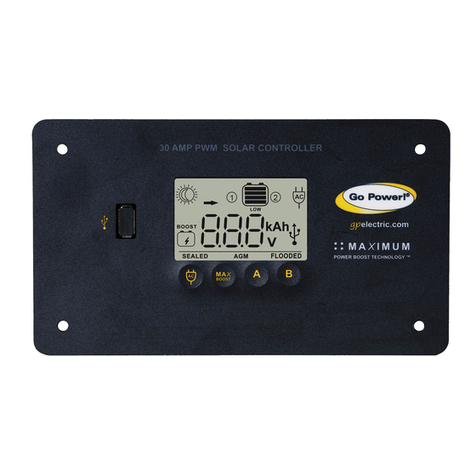
Go Power
Go Power GP-PWM-30-UL User manual
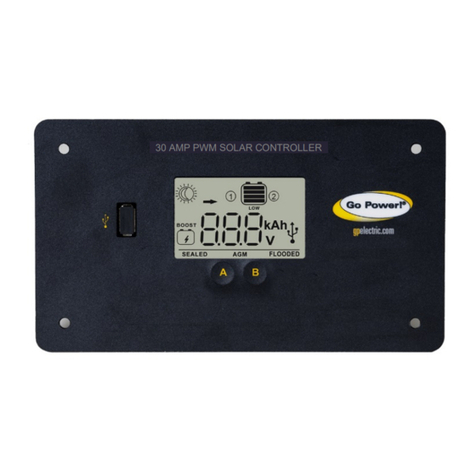
Go Power
Go Power GP-PWM-30-SB User manual
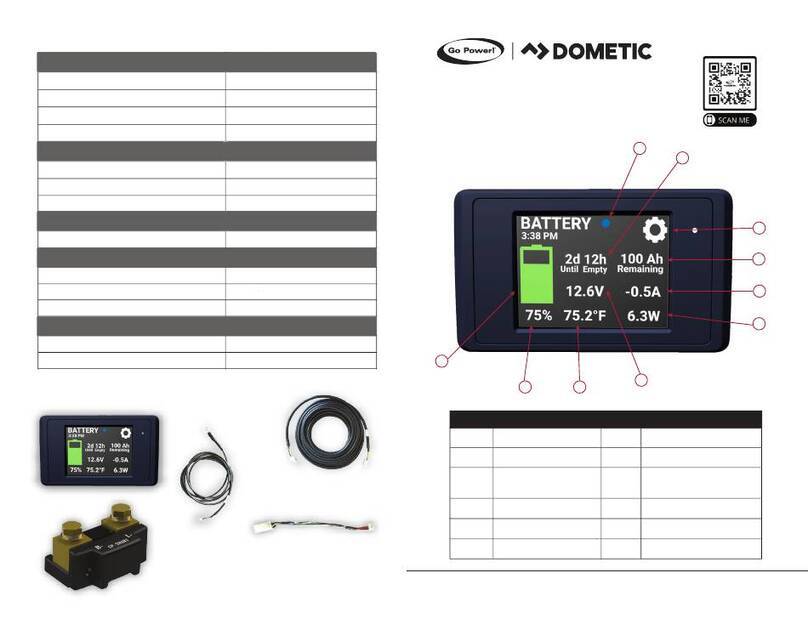
Go Power
Go Power DOMETIC GP-BMG User manual
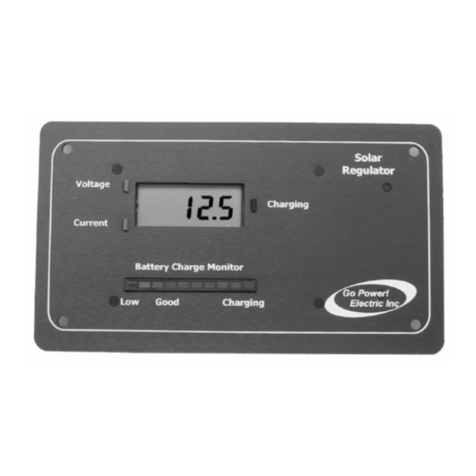
Go Power
Go Power GPR-25 User manual
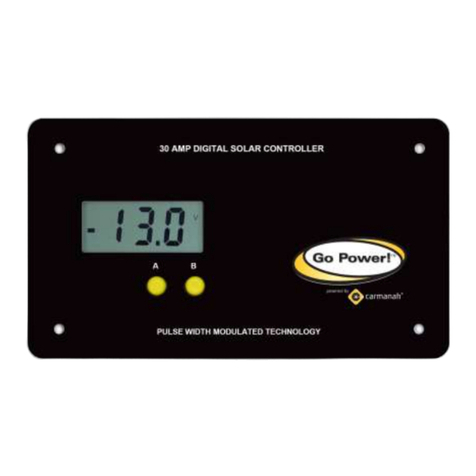
Go Power
Go Power GP-PWM-30 User manual

Go Power
Go Power GP-PWM-10 User manual

Go Power
Go Power GP-PWM-30-UL User manual
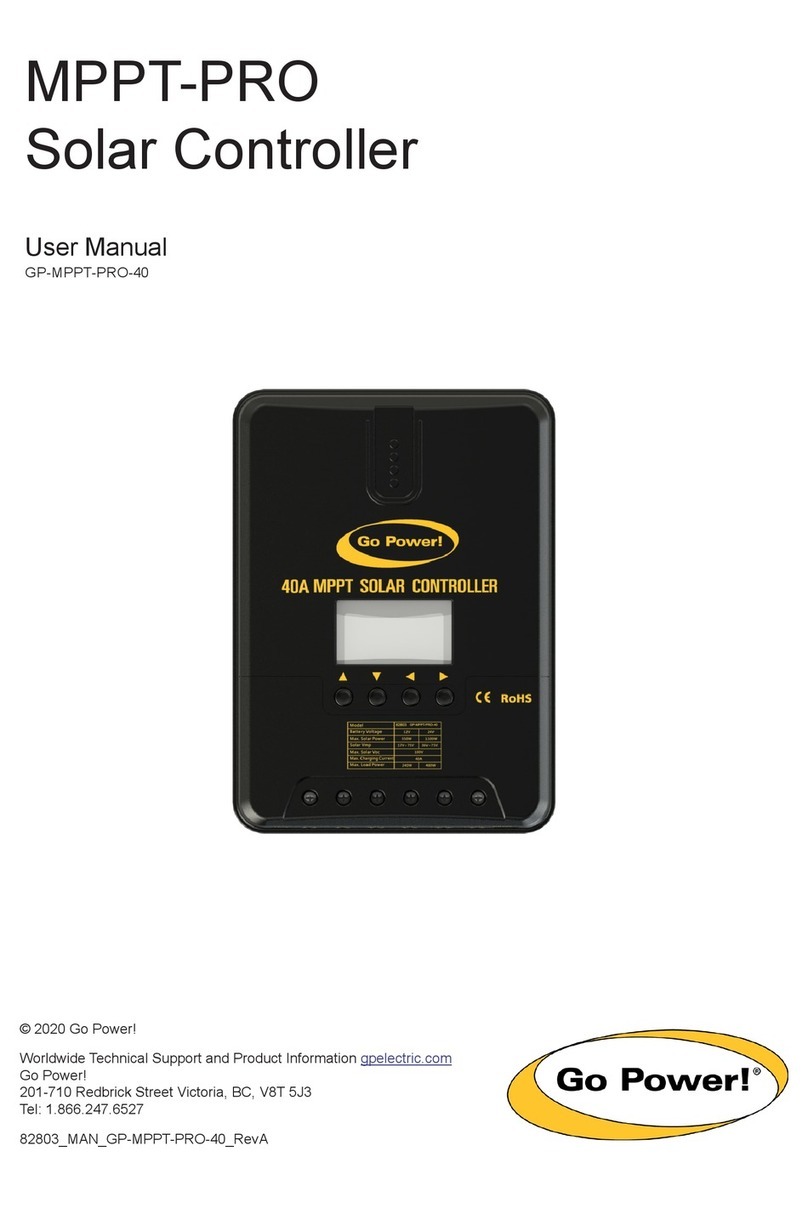
Go Power
Go Power MPPT-PRO User manual
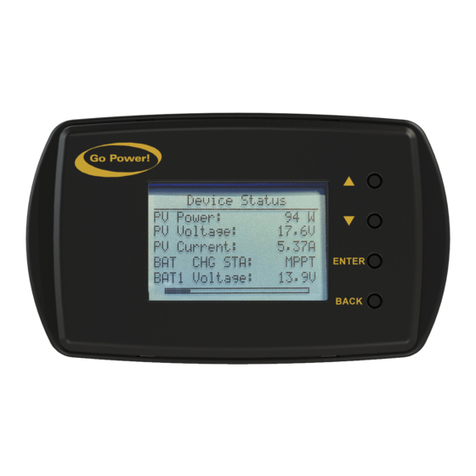
Go Power
Go Power GP-RVC-R User manual

Go Power
Go Power GP-DURALITE-100 User manual
